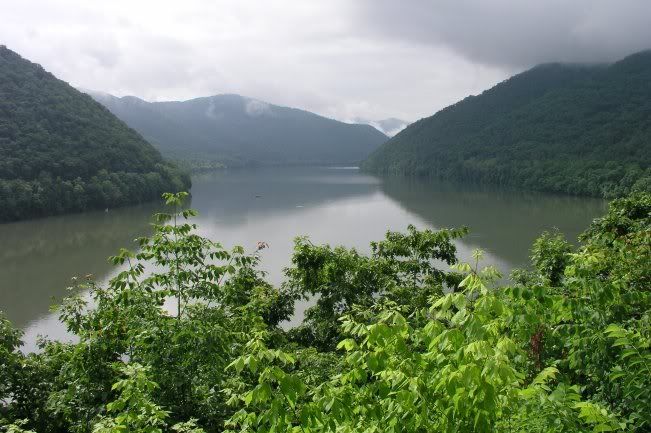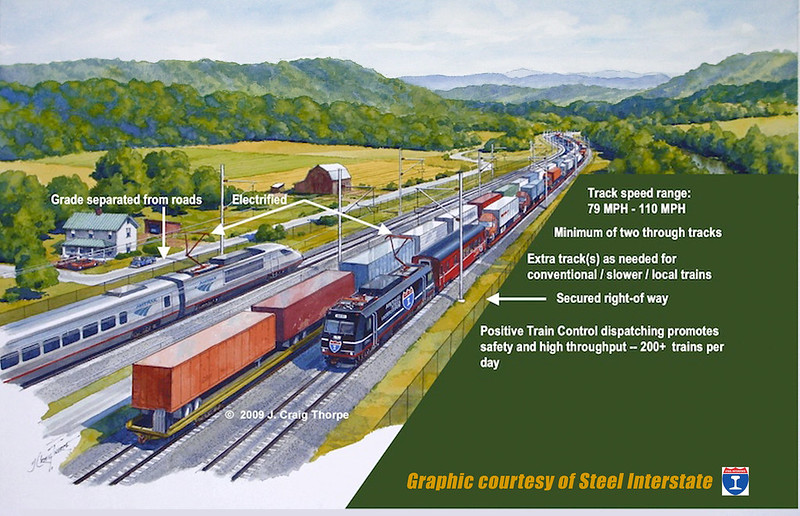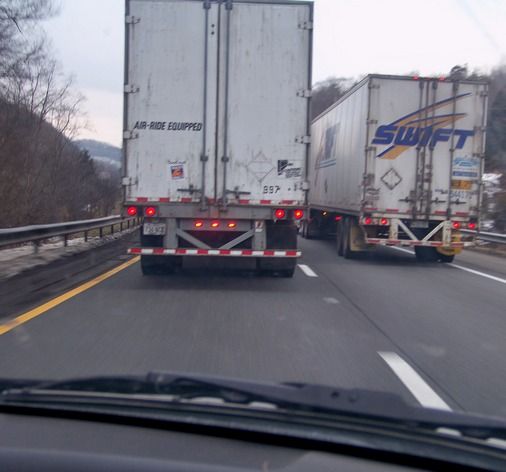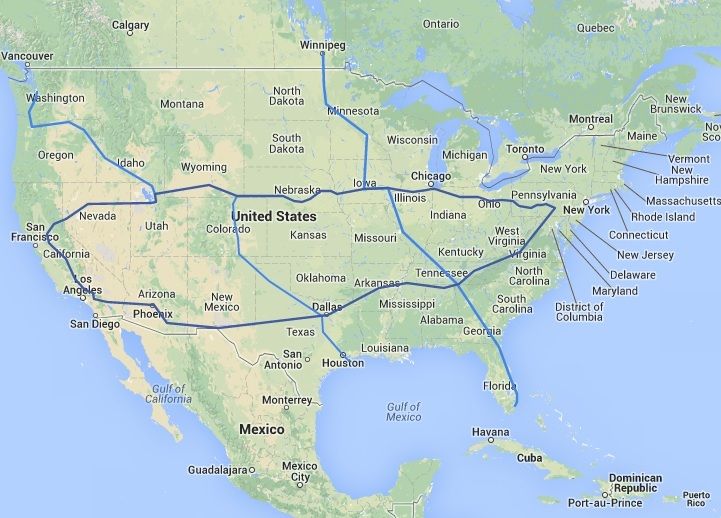So, we are two weeks into the Trump administration, and we see a runaway rush to promote economic suicide through pandering to oil and coal companies. Because, it would seem, the slogan was really “Make America Great At Propping Up Dead End Industries Again”, but #MAGAPUDEIA” had to be edited down, both for length and …
Tag: Steel Interstate
Jul 31 2016
Sunday Train: Washington State Labor Council support Steel Interstate Feasibility Study
Sunday Train has long supported the Steel Interstate concept … but Sunday Train is “merely” an online activity composed of my online blogging in various forums and your discussion in various forums. However, since 2013, I have also been involved in the advocacy of the Steel Interstate concept in a more direct collaboration organized by …
Mar 16 2015
Sunday Train: Five Levels of US Intercity Rail Policy
 In Sunday Train last week, I referred to the Bipartisan Majority to Authorize the funding of Amtrak as “Good News”. One commentator in the discussion in one of the crossposts pointed out that the news wasn’t all that particularly good, since continued funding on this basis over the indefinite future will spell serious trouble for the system as a whole.
In Sunday Train last week, I referred to the Bipartisan Majority to Authorize the funding of Amtrak as “Good News”. One commentator in the discussion in one of the crossposts pointed out that the news wasn’t all that particularly good, since continued funding on this basis over the indefinite future will spell serious trouble for the system as a whole.
Now, as I suggested more than once, the “good news” last week certainly was not unqualified good news … that is, to say it was “qualified” good news was already taking on board the bad electoral news for Amtrak in the continued Republican House Majority combined with a new Republican Senate Majority, which opened the door to some of the deep, slashing cuts to Amtrak that some on the Republican side have long hoped to make. So the “qualified good news” was that in going for a total defunding of Amtrak, the radical reactionary wing of the Republican party overplayed its hand, opening the way for a majority of House Republicans, along with basically the entire Democratic caucus, to authorize the continued funding of Amtrak at just about the levels that have been in place over the past four years.
But that was set against the bad news of the INDOT refusing to continue the Hoosier State service on the ground of basically not being allowed to have its cake and eat it too … insisting on acting like the organization putting together a passenger rail service, without being treated as a passenger railway. And so I started thinking about the Hoosier State / Cardinal corridor in the context of, on one hand, the very low bar for “good news” in transport funding with this Congress, versus the tremendous need we have for a massive wave of investment in transport that can be powered by sustainable, renewable energy. And to organize my thinking, I started to sort it out into five levels:
- Level 0: “Very Much Worse”;
- Level 1: “Barely Scraping By”;
- Level 2: “A Basic Skeleton Service Done Right”
- Level 3: “Incremental Growth”
- Level 4: “Aggressive Growth”
More about the five levels … below the fold.
Feb 16 2015
Sunday Train: Future of Rail Technical Symposium, Washington DC. 3 Feb, 2015
 Last week in Washington DC, your Sunday Train correspondent was able to attend the “Future of Rail Symposium” held in Washington DC. The presenters discussed various aspects of building a Steel Interstate corridor, including the Steel Interstate concept, a discussion of electrified rail around the world, why rely on electricity rather than LNG for major backbone corridors, the engineering and economics of electrification in North America, an approach to financing an initial Steel Interstate corridor without requiring new legislation to be passed through our gridlocked Federal government, vehicle and track considerations of the “Rapid Freight” rail component of the Steel Interstate, the labor dimension and the need for a new social contract with Rail Labor, and a final presentation on the “Solutionary Rail” proposal by the Backbone Campaign to establish a Steel Interstate on the BNSF Northern Transcon corridor.
Last week in Washington DC, your Sunday Train correspondent was able to attend the “Future of Rail Symposium” held in Washington DC. The presenters discussed various aspects of building a Steel Interstate corridor, including the Steel Interstate concept, a discussion of electrified rail around the world, why rely on electricity rather than LNG for major backbone corridors, the engineering and economics of electrification in North America, an approach to financing an initial Steel Interstate corridor without requiring new legislation to be passed through our gridlocked Federal government, vehicle and track considerations of the “Rapid Freight” rail component of the Steel Interstate, the labor dimension and the need for a new social contract with Rail Labor, and a final presentation on the “Solutionary Rail” proposal by the Backbone Campaign to establish a Steel Interstate on the BNSF Northern Transcon corridor.
Jul 14 2014
Sunday Train: Crutches vs Splints for the Highway Fund’s Broken Leg
From the Sunday Train
 There was a gleam of hope this week for state officials faced with the prospects of having to start delaying projects and lay off people working on maintenance and new construction funded from the Federal Highway Fund: Bloomberg:
There was a gleam of hope this week for state officials faced with the prospects of having to start delaying projects and lay off people working on maintenance and new construction funded from the Federal Highway Fund: Bloomberg:
Lawmakers’ fight over how to fund roads and transit probably will end with legislation from the Republican-led House sent to President Barack Obama, leadership aides in both parties said.
House and Senate leaders have been collaborating on a strategy for preventing the Highway Trust Fund from running dry at the height of the summer road-construction season. While bills approved July 10 by committees in both chambers are similar, the Democratic-led Senate’s version contains tax proposals seen as obstacles in the House.
But this is akin to lending someone with a broken leg crutches and hoping that it will heal on its own. For some fractures, that might work, but most would require a splint at least, and for serious fractures, you need to set the leg and put it in a cast of some sort.
In the case at hand, the long term broken funding model that lays behind the Highway Funding crisis is something that requires something better than a temporary loan of crutches.
May 06 2014
Sunday Train: Freight Transport and the Highway Funding Crisis
Belated edition ~ technical difficulties interfered with posting to Soap Blox blogs
 We are going to be hearing increasingly this year about the Highway Funding Crisis. Much of that discussion will be directed toward exploiting the political leverage that our car addiction gives to the Highway Lobby.
We are going to be hearing increasingly this year about the Highway Funding Crisis. Much of that discussion will be directed toward exploiting the political leverage that our car addiction gives to the Highway Lobby.
But there is the other side of the Highway Funding Crisis, which is freight transport. Our freight transport system has been as deliberately addicted to road funding as our passenger transport system, and in the process is quite heavily addicted to diesel fuel.
Now, the Sunday Train has frequently tackled this issue from the side of the physical unsustainability of our dependence on petroleum based fuels for a majority of our transport. However, its also the case that the system of public finance upon which we built our road transport system is becoming more and more financially unsustainable.
Mar 31 2014
Sunday Train: Our Trebly Broken Highway Funding System
 Over the balance of this year, you are likely to hear more and more about our broken Highway Funding system. For instance, William Moore, of the consultancy group Vianovo and member of the Transportation Transformation Group, wrote at Infra Insight this last 13 March that:
Over the balance of this year, you are likely to hear more and more about our broken Highway Funding system. For instance, William Moore, of the consultancy group Vianovo and member of the Transportation Transformation Group, wrote at Infra Insight this last 13 March that:
Absent swift action by Congress, state departments of transportation will begin to have cash flow problems that could delay payments to vendors and slow projects. Without action by the fall, new projects may have to be shelved until Congress can resolve the funding crisis that confronts the Highway Trust Fund.
However, this is just the most visible layer of pending crisis in our highway funding system. Even if we were to fix the threat to engage in spending at status quo levels,status quo spending has been falling behind the damage done by cars and trucks to our roads for decades, and even if we were to fund our transportation to address the massive shortfall in maintaining our current highway system, we have not seriously begun in addressing the fact that our current transport system is one of our principle contributor’s to our economy’s present climate change suicide course.
We have a trebly broken highway funding system, and there is no guarantee that we will actually address the simplest of the problems.
The good news is that we do not need massive technological breakthroughs to fix this triple layer cake of crisis. The bad news is that what we do need is a political movement with both the focus and the clout to push the existing available solutions onto the table, in the face of determined status quo resistance … and those who have at least glanced at our political system over the past decade would be aware that building such a movement is a “to be solved by reader” kind of problem.
Feb 17 2014
Sunday Train: Portfolio Theory vs the Myth of Intermittent Wind Power
 This last week, in the comment section of the EnergyCollective, I saw the same myth that I have seen time and time again regarding wind power:
This last week, in the comment section of the EnergyCollective, I saw the same myth that I have seen time and time again regarding wind power:
Fact 1: renewables are aleatorically intermittent, and so unreliable.
Fact 2: due to Fact 1, they cannot provide energy when it is needed, but only when and in the quantity they can
Fact 3: users have to get energy when they need it, not when it is aleatorically provided
Fact 4: to date, there is no storage system that can be useful for a complex industrial society
Fact 5: due to facts 1 to 4, renewables need to have a back up system that can cope with the needs of the users.
Fact 6: that back up system cannot be just stopped and then put to generation in a few seconds or minutes, and usually have to generate at low efficiency to maintain the back up at call point, generating added costs, besides the usuals as maintainance, lost profits, complex distribution grid, etc.
… not surprisingly ending with climate crisis denialism in “Fact” 8, since the name of the game here is clearly not arguing by starting with facts and seeing what conclusion you arrive it, but rather is myth creation and propagation in support of an already selected conclusion.
While many people don’t know what “aleatorically” means, many would actually share the misconception that windpower is an intrinsically intermittent resource. However, for wind power, the “Fact 1” is in many cases “Falsehood 1”. Even though individual wind turbines are intermittent, for many wind resource regions, it turns out that a substantial share of wind power is not intermittent at all, in either their “by chance (aleatorically) and unpredictable” component or their “by chance (aleatorically), though predictable” component.
Oct 28 2013
Sunday Train: Steel Interstate Revolution
 The Steel Interstate is a proposal to pursue dramatic gains in the energy efficiency of long haul freight transport in the United States, resulting in:
The Steel Interstate is a proposal to pursue dramatic gains in the energy efficiency of long haul freight transport in the United States, resulting in:
- Substantial reductions in Petroleum Imports;
- Substantial reductions in Greenhouse Gas emissions;
- Substantially improved protection from Petroleum Supply interruptions;
- Improved productivity for North American manufacturing; and
- Substantial reductions in damage to the existing Asphalt Interstate System
How can it promise all of this? By mining gross inefficiency. The United States has one of the most energy inefficient systems of moving freight long distances available under current technology, and we combine that with an economy that relies heavily on moving freight long distances.
Some of the specific sources of energy efficiency are:
- Moving cargoes in linked electric freight trains offers less air resistance than moving cargoes in individual trucks, because the freight car ahead provides a slipstream for the freight car immediately behind;
- Steel wheel on steel rail has less rolling resistance than rubber tire on asphalt road;
- Electric motors are more efficient than diesel or gasoline internal combustion engines; and
- When braking, electric trains can put a load on their electric motors and generate power, feeding it back onto the line
Overall, long haul electric freight is around 15 times more energy efficient than long haul diesel semi freight. I tend to express this as over ten times the energy efficiency, to allow leeway for possibly longer routings when taking advantage of the Steel Interstate.
Long haul electric freight trains are also more space efficient than long haul truck transport. Freight demands that would require multiple lanes each way just for truck traffic can be readily accommodated on a two track mainline route. This can be done while accommodating a mix of 60mph heavy freight and 100mph fast container freight by including regular extended sections of passing track: the difference between passing track and sidings is that on-schedule faster and slower trains using the passing track remain in motion, rather than one sitting still in a siding waiting for the other to pass.
Finally, the operating cost per ton-mile for electric freight for both 60mph heavy freight and 90mph fast freight is enough lower than the operating cost of long haul trucking that the government can fund a National Steel Interstate with interest subsidies alone, with Access Fees and User Fees refunding the original capital cost of the system ~ initially, funding expansion of the system, and finally funding retiring the bonds.
Sep 16 2013
Sunday Train: Rapid Rail and Pedal to the Metal Climate Change Policy (part 1)
 Earlier this month, Micheal Hoexter offered a “A Pedal-to-the-Metal Plan” to respond to the challenge of Climate Chaos at New Economic Perspectives, also crossposted to Naked Capitalism (part 1, part 2 and part 3).
Earlier this month, Micheal Hoexter offered a “A Pedal-to-the-Metal Plan” to respond to the challenge of Climate Chaos at New Economic Perspectives, also crossposted to Naked Capitalism (part 1, part 2 and part 3).
His plan is an overarching plan for a 15-20 year equivalent-to-worldwar mobilization of our economy for the purpose of reducing the degree of severity of the climate catastrophe that our economy has signed up for under status quo policies. What I am looking at this week is the role that Rapid Freight Rail and Rapid Passenger Rail can play as part of the mix of Pedal to the Metal Climate Change policies addressing transport.
There is a tremendous gap today between the maximum that is politically feasible and the minimum required to make a serious dent in the challenge that we face. This piece lies primarily on the “minimum necessary” side of our current political dysfunction, looking at necessary (though not sufficient) structural transformations of our transportation system. However, it is also address in part to the “maximum feasible” side, since these are policies that can be put into place on the back of only a partial political breakthrough, which may not on its own be enough to get a complete Pedal to the Metal policy package in place.
I argue that both Rapid Freight Rail and Rapid Passenger Rail can play the roles of “front-runner” policies on the transport side of a Pedal to the Metal Climate Change policy package. One of the things we look for in prospective front-runner policies is that the policies stand on their own, but they also strongly complement follow-up policies that we would look to put into place to complete the Pedal to the Metal policy package.

Recent Comments